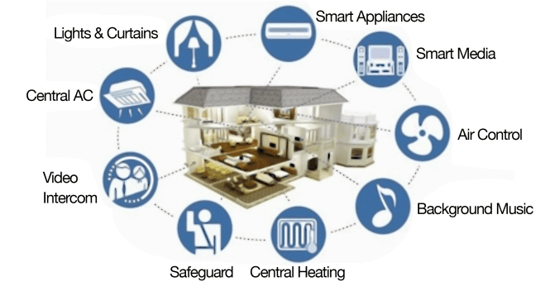We now have more cellphones than people in the world. This has led to the expectation that everything has to be at our fingertips.
Hence, smart home systems have become popular in the last couple of years. Not only have these devices become affordable but also easy to install and maintain.
With increasing economic growth, smart home systems are being adopted rapidly. Their benefits include:
- increased comfort
- rational use of energy
- enhanced safety and security
They also save energy as well as reduce costs and they can support measures for the elderly.
These systems can also be extended to smart metering. Smart meters track the use of electricity in your home and convey it back to the electric companies at a high frequency (eg, hourly). This enables you to receive feedback at a granular level about your electricity consumption. Your high electricity consumption of appliances such as washing and dishwashing machines can be adjusted to lower your electric bills.
The global smart home market is growing rapidly and is expected to reach $40.9 Billion by 2020.

Source: Statista.com
A smart home system helps you control and monitor various home systems like lighting, central heating, security and even locks at the entrance of your house.

A Smart Home system consists of various components, the center of which is a sensor. The sensor measures detects and provides feedback about the temperature, lights or motion detection based on the device it is embedded in. This information is then transmitted to your smartphone or tablet via the Internet.
Apart from the sensor, the smart home system also has controllers, actuators, data processors, and analyzers. These systems can be used either the wired or wireless Internet.
Let us take a look at the benefits of using sensors in these smart devices at your home that can help you live comfortably, economically and in an energy sustainable manner.
Temperature Control - Smart Thermostats:
Smart thermostats adapt the heating or cooling in your home based on temperature, humidity, and your preferences. This information is obtained from your mobile phone to determine where you are located and adjust the temperature accordingly. This saves energy, electricity and your utility bills. It is proven that these sensors can rapidly bring the temperature down within two minutes of you entering the premises. They also store the setting information for various times and utilize it to automatically set the temperature that you generally prefer. For example, if you had the temperature set to 69 degrees during the day and 71 degrees at night, it would automatically adjust the temperature to these settings. It is proven to save about 20-40% in energy costs.
Water Monitoring:
Imagine a faulty water faucet or hidden pipe leakage at your home. It can flood the area leading to loss of belongings, costly and time-consuming repairs. Water sensors prevent your home from flooding and alert you of any leakages potentially preventing serious damage.
Water sensors detect the presence of water and can be programmed to either send an alert to your smartphone or to a professional monitoring company. They can also be set up to shut off the water system to prevent further damage.
Lighting Control:
Lighting control sensors allow you to automatically detect your presence and turn lights on and turn off when you are not around. This saves energy compared to manually controlling the lights and spending energy when we are not occupying the home or room.
There are 3 different types of lighting sensors:
- Dimmers: Generally used with the indoor lighting they are used to dim the lights that helps reduce energy consumption. They can also be controlled by your smart devices.
- Motion/occupancy sensors: Motion sensors are used to automatically turn lights on when they detect motion and turn them off a short while later. They are very useful for outdoor security lighting. You can also use occupancy sensors inside the house to turn lights on and off when someone enters or exits a room. Photosensors are another option to prevent outdoor lights from operating during the daytime. This also helps save energy.
- Timer sensors: These help you program to automatically turn lights on or off during set times.
Smoke/Fire Prevention:
Traditional smoke detectors sound alarms and can be detected while at home. Smart Smoke alarm systems can send you an alert to your mobile device even if you are away from home. They can also be configured to send alerts to the fire department.
- Smart Smoke Detector: They detect the smoke particles in your home and send alerts to you as well as to the fire department. They can also be programmed to shut down the air handling systems to prevent further spread of the fire. You can also integrate this sensor with a camera so that you can visualize the location of the fire. They also send notifications when the batteries are due for replacement.
- Smart Fire Detector: A Smart fire detector will ensure that rapidly increasing temperatures are detected. This is an additional protection along with smoke detector, in case of false alarms from the smoke detector.
- Smart stovetop fire prevention: According to the National Fire Protection Agency, cooking fires are the leading cause of home fires and fire injuries. These sensors prevent cooking fires by using motion detection to automatically shut off the stove in case of unattended cooking on the stove. They would automatically restart once you return to the stove.
Smart Home Security Systems:
These devices help you protect your home with the help of remote monitoring, alerts, and notifications as well as remotely view or photograph visitors. Smart locks allow you to control your locks with your mobile device. Smart garage door delivers alerts when the door is left open and allows you to close it remotely.
Smart elder care sensors:
These sensors are helpful to take care of the elderly at home. The system typically learns the behavioral patterns and life-rhythm of the elders. Based on the information from doors and other home appliances, the sensor responds. Alerts and notifications are sent to caretakers and family based on your settings and frequency of information needed.
Implementing sensor technology:
Implementing sensors or smart home systems requires planning to ensure that all the factors that affect energy consumption are taken into account.
Whether you are designing a new house or remodeling an existing home, the following are some of the factors to consider while planning on implementing a smart home system:
- Appliances: How many appliances need to be controlled by the smart system, their location and if the current model supports integration with sensors.
- Insulation: What is the insulation in the house that can make or break your sensor installation. Is there a need to inspect and reinstall insulation?
- Natural lighting: What areas are lit during the day with natural light and what is the need for any lights to be controlled automatically?
- Space heating and cooling: This drives the need for setting up the thermostat. Are there any pets to be considered for adjustment?
- Water Heating: When is the water heating required and what is the desired temperature?
Apart from these factors, there are considerations to be made:
- What sensors should be selected? – Depending on your budget there are multiple options in the marketplace.
- Is there any integrated smart home system that you can implement? – This is easier in a new construction.
- What is the need for wired or wireless network and what is the speed requirement?
- What is the backup option for electric power in case of a power shut down?
Conclusion:
In conclusion, a smart home system can help with controlling multiple aspects of your house either remotely or automatically.
Sensors play a significant role in a smart home system since they form the core of the system.
In addition, the sensors offer various benefits to improve your housing facility by automated thermal controls, secure smoke alarm systems as well as motion detectors that help with lighting. They play an important role in reducing energy consumption and cutting costs of your utility bills.



